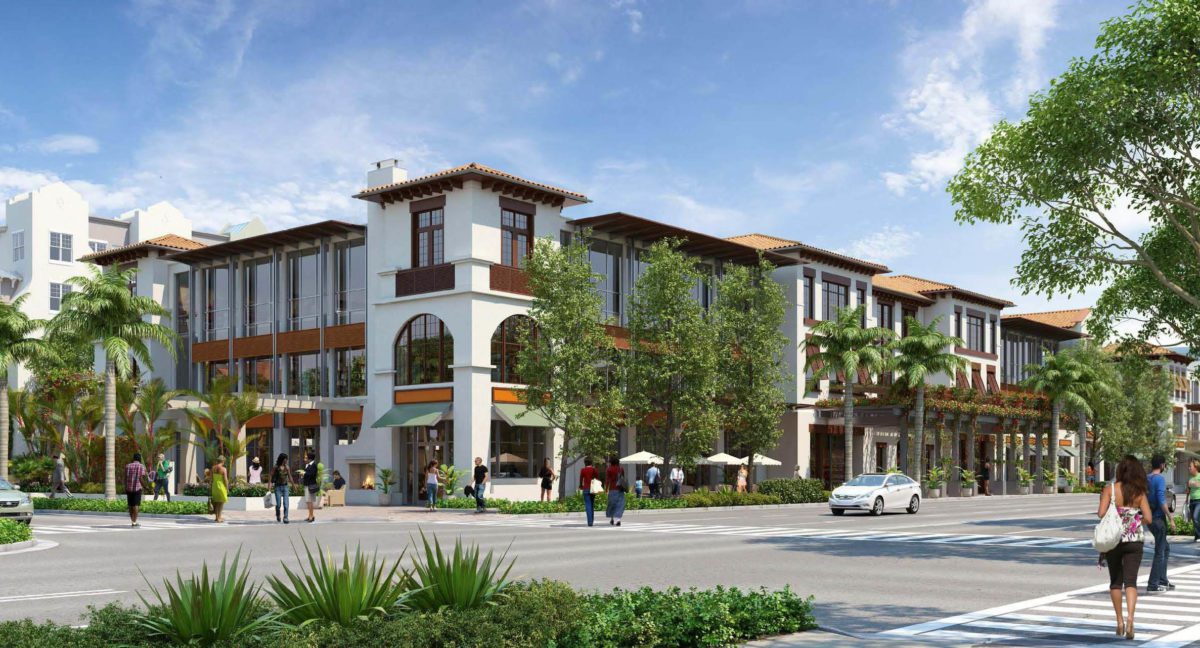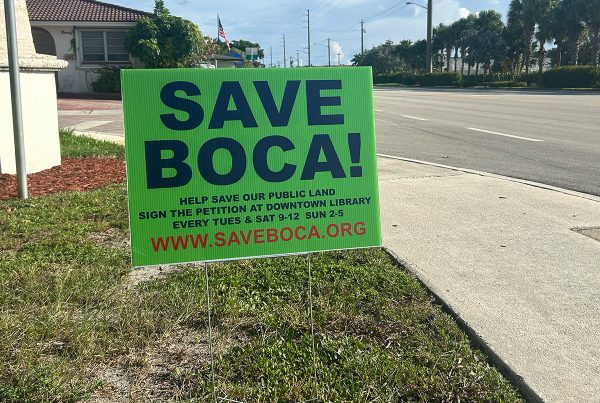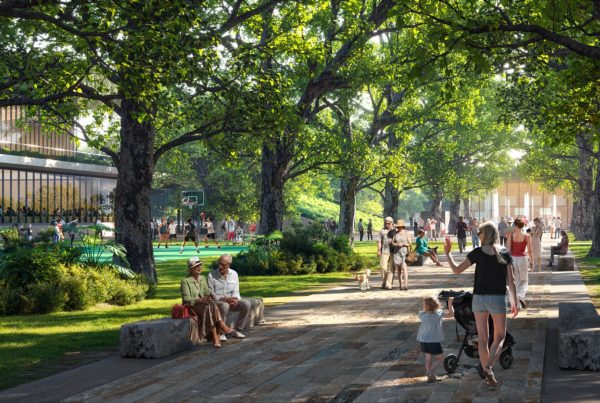Pictured above: View from Atlantic Avenue and Federal Highway looking northeast. Photo courtesy of Atlantic Crossing.
Atlantic Crossing update
Last week marked the fifth anniversary of the Delray Beach City Commission’s vote to approve Atlantic Crossing. Next month, serious work on the project is scheduled to begin.
How long has it been? How much has happened? When the commission approved it, Atlantic Crossing was called Atlantic Plaza II. By my count, the project has been through at least four iterations. There may have been more.
The final version will include 82 condos, 261 rental apartments, 83,000 square feet of Class A office space and 76,000 square feet for retail and restaurant. At one point, the project had 442 apartments. The non-residential space is less than the first version that the commission approved in 2008. It never got built. The project will take up the two blocks on Atlantic Avenue west of Veterans Park.
According to a representative for the developer, Edwards Companies, Atlantic Crossing is awaiting its site preparation permit. When the city issues the permit, work will begin on the western block that has been cleared. Excavation for the underground garage, the representative said, “should begin in January.”
Edwards expects work on the garage to take a year. But when the southern portion is done—the projection is for next summer—work will start on two of the six buildings that will comprise Atlantic Crossing. One will have retail at street level with offices above. The other will have retail on the bottom with apartments above.
Edwards expects pre-leasing of the apartments to start in late 2019. Information about the site plan and other details is available online at atlanticcrossing.com.
Hard feelings remain among some residents about that 2012 approval. Atlantic Crossing received conditional uses to go from a height limit of 48 feet to 60 feet and for nearly two-thirds more in density. The final version increased the density by closer to 50 percent.
Hard feelings also arose between the city and the developer. Edwards sued, claiming that the city was wrongly failing to issue permits.
The lawsuit got personal. It referred to “regime change” on the commission when Mayor Cary Glickstein and Commissioner Shelly Petrolia were elected in March 2013. They had campaigned against the Atlantic Crossing approval. Glickstein, the developer alleged, wanted revenge because he had sought to build on a portion of the property. Glickstein at the time owned Ironwood Properties.
Last year, a federal judge dismissed the lawsuit. The victory was significant, because the federal filing sought major damages. Still, the litigation was far from over, and Glickstein noted repeatedly that the city needed something on those two blocks. The Class A office space, for example, could help the city recruit more businesses.
Almost no one doubted the need to redevelop the site. The debate was over intensity.
So last March, the commission correctly approved a settlement with Atlantic Crossing. A third-party lawsuit could have snagged things, but that didn’t happen.
The Atlantic Crossing representative said the developer is “working to minimize construction impact on adjacent neighborhoods” and has “submitted a maintenance of traffic plan that’s in line with what the city and community asked for, which includes closure of Seventh Avenue at Northeast First Street from day one, using oversized planters so it will look as nice as possible.”
Aside from watching Atlantic Crossing finally appear, it will be interesting to see whether Edwards becomes a player in the March 13 elections. With a $250 million project, Edwards is the biggest development game in town.
Oops! We could not locate your form.
Boca’s Camino Square
Boca Raton has teed up the Camino Square project for review before the community appearance board on Jan. 16 and the planning and zoning board two days later.
Camino Square would go before the city council acting as the community redevelopment agency, since the site is on the southwest edge of downtown. It’s the roughly nine-acre shopping center that a Winn-Dixie store, now closed, once anchored. Most other stores are vacant.
The real estate division of Florida Crystals Corp., the West Palm Beach-based sugar company, proposes to build 350 apartments. In a news release, FCI Residential Managing Director Juan Porro called the project “the first true redevelopment of a blighted and under-utilized” downtown property.
Camino Square’s residential section would consist of two 77-foot buildings. FCI Residential notes that the height limit in the area is 100 feet and that the proposed density is less than allowed under Ordinance 4035.
Because the site is near the intersection of Camino Real and Southwest Second Avenue, city review will include the impact on traffic. FCI said the apartments would generate less traffic than that from a fully leased shopping center. Residential generates less traffic than office and retail.
FCI said it made changes after discussions with community appearance board members and an appearance before the Federation of Boca Raton Homeowner Associations. An FCI representative contacted me to arrange an interview with Porro. When I emailed questions, the representative said Porro would be “unavailable to participate in the interview at this time.” Two emails seeking a reason for the cancellation were not answered.
Boca’s waterfront proposals
Last week, Boca Raton’s waterfront consultant presented drawings for potential improvements of parkland along the Intracoastal Waterway. One of those properties was Ocean Strand, the undeveloped 15 acres that reach from the Intracoastal to the ocean just north of Gumbo Limbo Nature Center.
One problem: The city doesn’t own Ocean Strand. The owner is the Greater Boca Raton Beach and Park District. Chairman Bob Rollins said the district “should have been in on the front end” of any discussion about Ocean Strand.
Though Rollins said he likes the idea of Ocean Strand being a destination on the much-discussed water taxi—a “blueway” instead of a highway—any significant change to Ocean Strand is “not in imminent sight.” The district must pay for the acquisition and renovation of the former Ocean Breeze golf course and complete work on the new swimming and tennis center near Town Center Mall.
So unless the city council has other plans, Ocean Strand will remain perhaps the most valuable unused property within Boca Raton.
And those two oceanfront lots?
Rollins was more hopeful about the district buying two oceanfront lots to keep additional development off Boca Raton’s beaches.
The issue arose in late 2015. The owner of the lot at 2500 North Ocean Boulevard successfully challenged the zoning board of adjustment ruling that he could not build a single-family home on the undersized lot. The staff recommendation had been to overrule the board, and the council agreed, with Jeremy Rodgers dissenting.
The city and the beach and parks district then began talking about buying out the few landowners who might be able to build east of A1A. Rollins told me Monday that the district has had “favorable discussions” with the owners of 2500 North Ocean and another lot to the north. The owner of 2500 North Ocean still needs state permits.
Delray’s Arts Warehouse
I wrote recently about the opening of Arts Warehouse in Delray Beach. The city hopes that the incubator will help aspiring artists to become working artists. The job training is about making a living from the job.
Already flush with bars and restaurants, Delray Beach hopes that the arts and culture can further complement the downtown economy. With the artists’ neighborhood in Pineapple Grove, Old School Square, Arts Garage and others, Delray hopes for an increasing cluster effect.
Results of a study support the city’s bet. Americans for the Arts reports that in 2015 people attending nonprofit cultural events in Delray Beach spent about $40 each in addition to the cost of a ticket. Most of that probably is spending for food and drink before and after the event. Total non-ticket spending for the year was $10.1 million.
The study also showed that culture and the arts drew about 113,000 visits in addition to the 143,000 within the city. Actual numbers of people are lower because the same people attend multiple events.
Yet even if you presume that the study aimed to make the arts look as good as possible, the numbers show what the arts have brought, and can bring to Delray Beach.








Hey Randy did you think maybe the FCI representatives were on vacation for the holidays. LOL Is there a conspiracy in everything?
RE: the positive effects of increased visits to Delray. From the City’s perspective, increased visits increase public safety and related costs, while generating minimal City revenue. Thus Delray’s taxpayers heavily subsidize a Disney like experience for visitors. In many states, state legislatures recognize this problem and municipalities are permitted to charge “tourist taxes”, for example on “spending for food and drink before and after the event”. In Florida, this is not possible.
Wondering how unaffordable the new units will be at Camino Square, sandwiched between the lovely amenities of the FEC tracks and the track marks on the temporary residents at the Boca House Rehab facility…
Luxury apartments anonymous poster–and the same will INCREASE PROPERTY VALUES provide much needed activity in the area, etc. In case you missed it all the apartments that back up to Congress Camden, Boca Walk, etc. are across from tracks. Many of the sober houses in the area have already been closed or sold based on the fact this project is coming–i.e. more eyes and police presence. The purpose of the CRA is to help fix a blighted area. This is the only real area in the City that is blighted–that is why there are sober homes there–captain obvious! I suppose you prefer the CLOSED run down beat up 1970’s shopping center that if was in full operation would create MORE traffic than the proposed luxury project. Once the residential is approved there will probably be a low intensity high end retailer (maybe an urban style grocery store) join the site. The tax base for this property will quadruple and there will be new landscape and a beautiful structure the parking garage of which will block noise from the tracks as an added benefit. All SFR property values in this area will increase in value by 3-5% just as the result of this project and clean up of area.
You’ll be amazed how many of the world’s greatest cities have ultra-luxury properties next to what is undesirable, and I’m not talking about tower blocks for the rich next to shantytowns in Latin America. Along the FEC tracks and right next to a train station which could be used again for Coastal Link and/or Brightline, these apartments and following retail phase will make great transit-oriented development, as opposed to transient-oriented development HA!
What are you talking about? Atlantic Crossing will greatly benefit Delray like Mizner did with Boca. Property values will soar and even more money will flow in the form of tax revenue and economic development.
We might be in violent agreement; masked by our commenting on two different topics. I agree with your comments on Atlantic Crossing, in addition to being sick of looking at two undeveloped blocks for what seems like a decade. What I was saying is that the continuing encouragement of Delray’s tourist economy (nothing to do with Atlantic Crossing) comes with high City costs and brings in no direct revenue.